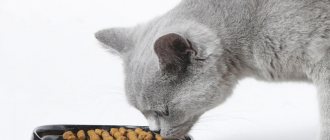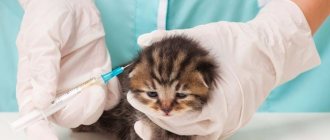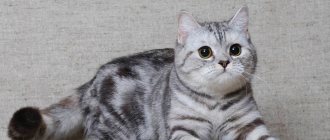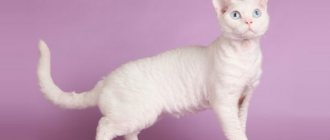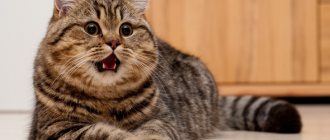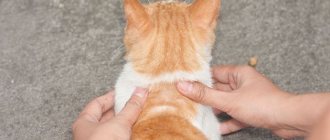British cats, both baby kittens and adult cats, need proper and healthy food. It is believed that this cat breed originates from the Cheshire cat from the famous Alice in Wonderland. In fact, the British cat breed was first recognized in 1871. This happened at the first London Cat Show.
Representatives of the British breed have a strong build, well-developed chest muscles, a not too long tail, strong dense paws, and a round head. The main features of the British are their dense coat, which looks like a plush coat of a special color, and a slightly flattened nose on the muzzle. There are more than 229 coat color options, each of which has its own standards. The blue shade of wool was considered classic, although other color options have now gained popularity.
British kittens of different colors.
How to choose the right British kitten
Sometimes you have to wait several months for a good pedigree baby from a specialized nursery. Usually kittens older than three months are given away from nurseries. At this age, babies receive all the necessary vaccinations. In the first month, the state of his health becomes clear. When choosing a baby, it would be a good idea to look at his parents along with photographs of the baby himself. You shouldn’t give up on the animal’s pedigree. Without this, even the most purebred cat becomes an ordinary yard cat. When choosing a little Briton, you cannot rely solely on his photographs.
It is better to find time and come to see your future pet in person. It is important to see it in your usual home environment. It is important to pay attention to his diet, what he is fed and what he likes. It is important to personally make sure that the animal knows what a litter box is. To do this, you will have to wait until the kitten goes to the toilet. Veterinarians advise listening to the cat - holding the cat to your ear and making sure that your furry friend does not have glanders.
At first glance this may seem strange, but the British breed sometimes has natural errors. The kitten may have deviated nasal septums and blocked tear ducts. This usually comes from the structural features of the skull.
If this is present, the animal’s eyes will constantly water and a characteristic noise will appear when breathing, similar to a quiet sniffle. When choosing a furry friend, many people advise checking the condition of his gums for the presence of gingivitis. This is not an uncommon occurrence for this breed.
Together with the animal, ask for its passport, which contains all the vaccinations given since birth. Many breeders give away his litter tray, favorite toys, and scratching posts along with the pet, but this depends on the person from whom the British baby is purchased. The breeder will also give some recommendations on care, feeding habits and other tips.
British Fold kitten price
Extensive selection work, active popularization and promotion of the British breed have somewhat reduced the initially exorbitant prices for kittens. But the priority pricing factor is still the quality class of the pet. The most expensive and prestigious are representatives of the “show” category: the minimum price for them ranges from $300 to $600. A breed class pet will cost $150-$160 less. A purebred “pet” kitten can be purchased for $150-$200.
We should also talk about buying a British Fold kitten. The paradox is that the breed is not officially registered by any felinological organization, but advertisements for the sale of such babies are quite common. We are talking, apparently, about mixes from a British cat and a Scottish fold cat.
Important! Such matings were previously allowed, but led to the fact that British-type kittens received elongated body proportions, while Scottish kittens received more massive bones. The risk of congenital anomalies in individuals resulting from such marriages is also high.
In general, this origin does not make the kittens less charming than the genetically “correct” British, but it does indicate that breeders in their work neglect the ban on interbreed marriages, control of matings and birth rates. The cost of British fold kittens is quite modest - about $100, they are purchased only as a pet: such animals will never have a pedigree and the right to participate in exhibitions, as well as in further planned breeding.
Return to content
How to determine the sex and breed of a kitten
Usually cats give birth to several kittens. Immediately after lambing they are very small and wet. Outwardly, newborns do not at all resemble representatives of the cat family. Their appearance changes greatly within a few days after birth. They become covered in soft fluff and become tiny, cute little balls. The average weight and height of kittens up to one year old is shown in the table.
Average weight and height of kittens up to one year old.
After birth, questions arise about the gender of the kitten. It is possible to accurately determine gender only after several weeks. During this time, the baby will already be formed. Many people think that gender can be determined by the behavior of an animal. However, this is a misconception, as girls and boys can behave in exactly the same way.
It is best to entrust this issue to a veterinarian or an experienced breeder. There were cases when the owners believed that they had a cat Vaska. And a year later it turned out that this was Vasilisa’s cat.
Another erroneous method is to determine gender by the nipples on the stomach. This opinion is also incorrect. Both females and males have nipples, sometimes nipples can be more pronounced on girls, but this is also not the most objective or reliable way to determine gender. The sex of a kitten can be determined by the size of the animal. As a rule, males are larger and boys have larger heads than girls. Females have a more proportional build. This method also does not guarantee an accurate result.
Where is the best place to get a kitten?
The choice of a cat of the British breed should be taken very seriously. You cannot purchase a pet from street vendors, markets, or in passages or subways. A self-respecting breeder who values his reputation will never take his “wards” out onto the street or into a public place. It is better to choose specialized breeders or nurseries. Be sure to check the reliability of this nursery. Breeders involved in the British breed can be found on special websites.
What to buy for a British kitten
Before a new resident appears in the apartment, you need to purchase the items that the kitten will need. You need to have everything you need in advance. This is necessary for the animal to cope well with the move to a new place of residence. This way the adaptation will be as comfortable as possible. The most necessary things to buy are:
- tray;
- tray filler;
- claw point;
- food bowls;
- water bowl;
- carrying;
- various toys;
- animal care items.
It is better to choose metal or ceramic bowls for food.
The cat should have at least three bowls - for water, for dry food, for wet food. It is better to choose a tray for the animal with high sides so that its contents do not spill out onto the floor or walls. To make cleaning the tray easier and more hygienic, you can purchase a special scoop for cleaning up waste. To prevent your pet from damaging furniture and walls, you need to purchase a special scratching post. It can be a single column or a whole complex consisting of various blocks, houses, shelves. The scratching post should be covered with sisal or jute.
How to care for a British kitten
There are several rules in caring for a British cat, following which, the cat will feel comfortable and safe. Proper care of a cat is the key to its health and long life. The main rule concerns nutrition. Since cats have developed muscles, they need a diet high in protein. The diet should also contain biotin, vitamins (especially groups A and B), and micro-macroelements. These elements have a positive effect on the color of the animal and the condition of its coat. The second rule of care is grooming. A cat needs to be accustomed to grooming procedures from childhood. The stages of grooming are:
- ear cleaning;
- teeth cleaning;
- combing;
The cat must be examined regularly. It is recommended to check the condition of your ears once a week and clean them if necessary. If there is a rash, irritation or unpleasant odor in the ear, you should seek veterinary help.
Nails need to be trimmed twice a month. Before doing this, you need to check the condition of the paws. You need to clean your eyes regularly. Black plaque accumulates in the corners of the eyes and needs to be removed. It is better to do this with a piece of cotton wool or a cloth soaked in warm water.
The British cat needs to be brushed regularly. It is often not necessary to carry out such a procedure, but some representatives of the cat family really like this procedure. You will need to purchase a comb. It is better that its teeth are made of soft rubber. Combing can be done according to the growth of the coat or against it. Such movements are an excellent massage; they improve blood circulation. You should not wash your animal frequently; it is better to carry out regular dry cleaning with special shampoos that do not require water.
Material on the topic: what is the British cat breed.
What and how to feed a British kitten
Despite the fact that the British have enviable health, they have a breed tendency towards obesity. It is necessary to control the pet's weight.
Natural products
British shorthair kittens can be switched to natural food, but this does not mean that the animal should eat from the owner's table. What food guarantees the healthy development of a Briton:
- Meat is the No. 1 product on the cat’s table! He is given 3/4 of the diet. Since British cats quickly gain weight, it is better to stick to dietary meat dishes. To prevent the animal from becoming infected with parasites, the meat is first frozen and boiled, and served finely chopped. Breeders recommend turkey, lean beef and chicken.
- Vegetable protein in the form of vegetables and beans should make up 1/4 of the daily food intake.
- It is better to give porridge to British kittens not in its pure form, but with minced meat. Suitable raw materials are buckwheat, oats and rice.
- Eggs can serve as a source of protein for the normal development of your pet. The protein of one raw or boiled egg per week is enough.
- Should kittens be given milk? Surprisingly, no. More precisely, until six months of age, complementary foods can be introduced in the form of special milk for kittens, but in maturing animals, lactose is less absorbed, which can lead to digestive disorders.
- Fermented milk products can be included in the British menu in moderation (a spoonful of sour cream, fermented baked milk, or cream is quite enough).
Feeding dry food
Most breeders insist that British kittens should get used to food specially formulated for them, rather than eating human food. Natural food is expensive and requires processing; moreover, it is stored for no more than two days. Dry food is more convenient for busy owners, but you need to choose it wisely.
Criteria for choosing dry food for British kittens:
- For purebred cats, premium or Holistic food is preferred (this designation indicates that the meat of animals raised on eco-farms was used to make the food). Cheap products are best avoided.
- Foods high in plant carbohydrates are not suitable for British kittens, as they lead to rapid weight gain, and British kittens have a breed tendency to obesity.
- Before purchasing, check the expiration date of the product.
The best dry food for British breed kittens are Earthborn Holistic, Royal Canin Size Nutrition Mini Junior and GO! Sensitivity". These are mid- and high-class products manufactured according to European standards.
In addition to dietary meats, they contain grains, vegetables, fruits and beans. Dry granules will be a good help for kittens who are teething.
Wet food
Wet food for British shorthair kittens is available in the form of pate and meat pieces in sauce. It is convenient because it will not be difficult for kittens to chew the soft mass. As complementary food, canned cat food can be given to kittens from one month of age.
How to choose wet food for little Britons:
- Ask the breeder what and how the animal ate in the nursery. Ask to see or give a bag of food with you. Usually breeders do this themselves.
- Purchase premium, super-premium and holistic food classes.
- Buy small portions of food, since the kitten will not eat everything, and canned food cannot be stored open for more than a day (in the refrigerator).
What not to give
What not to feed British kittens and adult cats:
- Human food. Many cats have unusual food preferences. For example, some of them may like candy, while others may like condensed milk. But this does not mean that you can pamper your pet with sweets: sugar is contraindicated for cats.
- Cheap, low quality food that fills supermarkets. “Kiticat”, “Felix”, “Friskas”, etc. are low-grade products made from meat waste.
- In addition to sweet dishes, spicy, salty and smoked food is prohibited on the cat menu.
- British cats are prone to gaining extra pounds, so they should not be fed fatty meats. It is better to avoid pork, lamb and fatty beef.
- Finally, there are foods that are dangerous for domestic cats of any breed. These include: all types of citrus fruits, garlic, onions, eggplants, potatoes.
How to feed
The nutrition of British Shorthair kittens is based on age, weight and health status. Normally, kittens are weaned from their mother at the age of 4 months. Responsible breeders will not sell newborn purebred kittens, but will accustom them to a certain type of complementary feeding in the nursery.
- Kittens at the age of 1 month are fed milk at room temperature every 3 hours. For this purpose, special formulas similar in composition to breast milk are preferred.
- Minced meat and milk porridge can be fed to a British kitten from 2 months. However, mother's milk or similar milk should be the baby's main diet. Complementary foods are added to the diet in small portions up to 7 times a day.
- A British kitten at the age of 3 months can be introduced to eggs, boiled fish, pureed vegetables and fruits.
- At 4 months of life, the animal should eat 4 times a day. The menu can be varied with fermented milk products, lean meats (rabbit, chicken, turkey).
- After 10 months, British seals and female cats are switched to an adult diet. There is no need to give milk, and meals are provided 2 times a day.
What to feed the British - the best food
The diet of kittens is different from the food that should be fed to an adult British cat. There are other nuances: after castration or sterilization, it is necessary to transfer the animal to a special diet to avoid rapid weight gain.
The best food for baby British cats:
- “Gourmet” (pate, easy to chew and digest).
- “Hills Science Plan Kitten Tuna” (the manufacturer produces dry and wet food for kittens, based on tuna and chicken meat).
- Royal Canin "British Shorthair Kitten" (food specially designed for kittens of the British breed. Contains fish oil, chicken meat and vitamins).
What to feed an adult British cat or a grown-up cat:
- “Acana” (Holistic food, created from different varieties of lean meat with the addition of vitamins and microelements).
- "GO!" (Holistic class food, environmentally friendly, hypoallergenic, made from natural meat).
- Royal Canin “British Shorthair” (the company produces food that takes into account the breed characteristics of animals and is a sponsor of cat shows).
What to feed a sterilized cat or neutered male:
- Royal Canin “Sterilized 37” (meat + fish).
- Acana “Light & Breed” (meat + fish).
- Eukanuba "Sterilized" (lean meats).
The calorie content of British food should not exceed 70 kcal per day. If a male or female cat participates in exhibitions, remember: according to the standard, the weight of an adult British cat should not exceed 8 kg (castrati - 12 kg).
When do kittens' eyes change color?
When purchasing an animal, many people pay attention to the color of its eyes. Indeed, this breed is distinguished by a beautiful shade of not only its coat, but also its eyes – gray-blue. But it is worth paying attention to the fact that as the cat grows up, it may change. It is impossible to determine the future eye color of small kittens. This can only be done a few months after birth, since by this time the animal will have completed its first molt.
It is possible to give a more accurate assessment of eye color only at one year of age, but by four months it is possible to predict the color. For the British, it depends on the coat color. At this age, experts will tell you whether the eye color will be yellow or dark orange. When choosing a small pet, it is best to pay attention to the health and condition of the eyes. They should not water, be cloudy, and the third eyelid should not be visible. The gallery below presents a selection of British kittens of different coat and eye colors.
Sexual development of the British kitten
The period of sexual development begins at six months for the British. But, if cats mature and grow for a long time, usually up to two years, then the situation with females is different.
At seven to nine months the first estrus may begin, and by ten to twelve months the cat is ready to bear and give birth to offspring.
The duration of estrus is from seven to ten days. If fertilization does not occur, then after two to three weeks it will begin again. The female becomes irritable, excited, sometimes even aggressive, screams loudly, some individuals mark their territory like cats.
If the British female is not intended for breeding, then after one or two heats it is necessary to sterilize. You can limit yourself to taking sedatives, but if they are plant-based, they are usually ineffective.
Hormonal drugs reduce sexual activity, but they can destroy a cat’s genitourinary health within six months of regular use.
“Empty” heats not only cause anxiety for the whole family, but also cause the development of endometriosis and pyometra in the female.
Toilet training a kitten
Domestic cats usually have no problems with litter box training. In order for the kitten to understand this as quickly as possible, you need to approach this issue correctly and in a timely manner. The tray must be prepared before a new “tenant” appears in the house. As a rule, breeders train small kittens to use the litter tray in advance, before they are given to a new owner. In this case, all that remains is to buy a new tray and filler for it.
According to physiological characteristics, kittens go to the toilet immediately after eating. At first, you need to take your baby to the toilet immediately after eating. This way the kitten will understand what is required of him. You need to carefully grab the fluffy one by the belly and make sure that the kitten does “its business.” If the kitten went to the toilet in the wrong place, you should not shout at it, much less hit it. It is also not recommended to poke an animal into a puddle it has made.
Interesting read: all the information about British cats.
It is enough to tell the little one in a stern voice that they are unhappy with him. Cats understand human intonation. After this, you need to take the animal to the tray and rustle with the filler. The place where the “crime” occurred must be quickly treated with special cleaning agents so that the kitten is not drawn there by the smell. It must also be remembered that good toilet behavior is fully formed by six months. In order for a kitten to use the toilet correctly, the tray must first of all be comfortable.
Breeders' advice
Breeders who value their reputation, love their work and their British cats are not indifferent to the future fate of the graduates of their catteries.
Therefore, breeders are always ready to help new kitten owners with advice and action.
- The first days in a new home are the most difficult for a baby. In order for him to get used to it faster and not experience much discomfort, you need to give him maximum attention: talk to him more often, play with him, just be near him.
- As a rule, British kittens have already mastered the litter tray perfectly by the time they are released. The owner’s task is to show the baby where this important item is and ensure its constant cleanliness: fresh litter of the usual brand or a tray that is always washed after each visit if an adsorbent is not used.
- Even before the kitten arrives, you need to decide on its nutrition system, whether it will be ready-made or natural food. To avoid problems with your pet’s digestion, you should always adhere to the chosen type of feeding. The recommended commercial food for British kittens should be at least premium.
- Although the British have excellent self-grooming skills, we should not forget about such hygienic activities as cleaning ears, teeth, trimming nails, and bathing.
- Timely vaccinations and preventive veterinary examinations are required throughout the animal’s life. Changes in well-being and behavior - refusal to eat, lethargy, apathy, dull eyes - are a reason for an unscheduled visit to the veterinarian. Attempting to treat a sick pet on your own can cost him his life.
And no less important than all these manifestations of care are the relationships with the pet, which need to be built from the moment it appears in the owner’s life. British cats are noble, self-respecting animals that do not tolerate indifference or rudeness . But they will return a hundredfold to a person’s sincere affection and love.
Return to content
Raising British kittens
Individuals younger than 6 months are more amenable to training, and most of their skills are acquired before the age of three months. But this does not mean that it is impossible to accustom and educate a Briton older than this age. You can raise any pet and correct already acquired habits and habits. British cats have a good and developed level of intelligence and with sufficient attention and effort, she can be trained to meet her requirements.
Already existing bad habits cannot be unlearned with a simple “Don’t.” At the moment when the cat does something forbidden, you need to shout loudly, whistle or make any other loud sound. This will create a feeling of fear in the cat. But we must not allow the cat to become afraid of its owner. If the goal is to re-educate and, even more so, change the character of a British person, you need to be patient. This may take a long time. Don't scold the cat.
When the cat does what is required of it, the cat should be praised and given something tasty. If a cat sharpens its claws in the wrong place, for example, on furniture, walls, or chews on indoor plants, you can use several tips that work for British cats:
- You cannot scream or hit the animal. The pet may harbor a grudge against the owner or begin to be afraid of him.
- If he behaves badly, you can sprinkle water on him.
- Suddenly and imperceptibly clap your hands if the cat begins to do the forbidden.
- Spray the crime scene with an air freshener, preferably one with a citrus scent. Cats cannot stand this smell.
Raising British kittens is a simple process. This breed is easy to train and very intelligent. The main thing is for the cat to understand who is in charge in the house.
Proper education of a British kitten
Raising a British child cannot be put off until later. It must be started immediately, from the first minutes in the house, acted kindly and persistently. In no case should shouting or physical punishment be used against an animal.
Subordination and respect for the owner
First of all, the pet must understand that the most important leader in the house is the owner and he must obey him unquestioningly. Usually, if a person does not scream, but strictly and firmly reprimands for a mistake, and affectionately rewards with a treat or toy for correct actions (for example, using a scratching post), then the baby quickly recognizes the owner’s leadership.
It is important to become an indisputable authority for the British from the first days, then there will be no problems in the future mutual existence.
Toilet tray
Usually the toilet issue is the biggest concern of the future owner. But, if you follow all the breeder’s recommendations, then no problems will arise.
Choosing the right tray, limiting the pet's movement around the house in the first two days and the owner's persistence will help solve this problem.
If the baby does not go to the toilet for a long time, then you should drop him off there 10-15 minutes after eating.
Filler taken from the mother's tray helps a lot. A familiar smell will quickly evoke the necessary associations. In the future, it is advisable to leave a little used filler and mix it with clean filler.
If the little Brit gets lost in the first days and forgets where his toilet is, then you can place several trays around the house.
If embarrassment does occur, do not scold the baby. This is not a whim or harmfulness, but the result of stress and fear. The mark must be washed immediately with special products. The disinfectant composition for veterinary use Verocid has proven itself well - it removes any odors. Sometimes toilet training sprays and products like Antigadin help.
At first, you shouldn’t let your kitten uncontrollably onto beds or sofas. If it marks your upholstered furniture, it will be much more difficult to remove the smell. When the period of stress passes, the toilet problem will disappear on its own.
scratching post
A three to four month old British kitten adopted from a nursery will most likely know how to use a scratching post. Even if the excitement of moving made him forget his old skills, they will quickly be restored if the owner behaves correctly.
If space is limited in the first days, the scratching post should be placed next to the house. If there is nothing else suitable for sharpening his claws, the baby will quickly recall his mother’s lessons in his memory.
Feeding a one-month-old British kitten
Proper nutrition for a British person is a key factor in healthy development. There are two feeding methods - cooked food and ready-made food. Veterinarians are confident that the first option is better. With proper nutrition, the kitten receives all the necessary substances required for its small body. A one-month-old baby should be fed finely pureed meat. It is better to use beef and chicken for this.
You should not choose pork for this, as it contains too much fat, which negatively affects the animal’s digestive system. The diet should also include fermented milk products - kefir, sour cream, low-fat cheese. You need to feed your baby at least 6 times a day in equal portions. If you don’t have the time or energy to carry out these operations, you need to choose specialized food for small kittens. The main thing is that it is of high quality.
Feeding a one-month-old kitten.
Kitten over six months old
For a teenage kitten, any products that he likes are suitable. The main thing is not to use products that can harm your health and cause suffering. Cats should not be given bones as they can damage their digestive organs. The diet should not contain poultry, lamb, or pork. These types of meat are poorly digestible for animals and can cause harm to them. Also, you should not give British leather all types of smoked meats, sausages, and frankfurters.
You should absolutely not give your pet sweet, salty or peppery foods. Products containing pepper can damage your cat's sense of smell. You should not add beans and potatoes to your food. These products negatively affect metabolism.
British kitten six months old.
